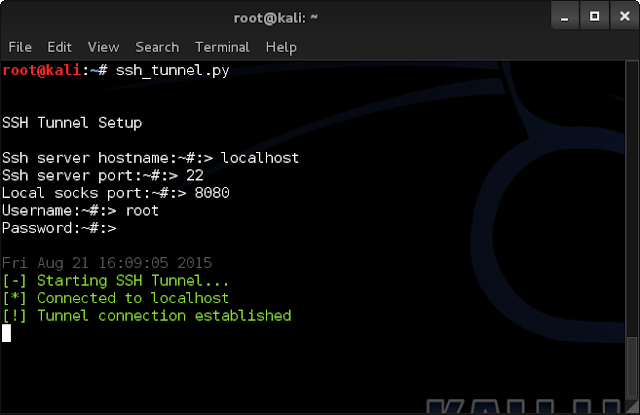

- #Ssh tunnel python how to#
- #Ssh tunnel python mac os#
- #Ssh tunnel python install#
- #Ssh tunnel python code#
- #Ssh tunnel python password#
While modules like Paramiko and sshtunnel provide excellent SSH and SSH tunnelling. Even though this does not use paramiko, I believe it's a very clean solution to implement (similar to dario's answer but without managing the thread in python). Multiple -M options places ssh into master mode with confirmation required before slave connections are accepted. Once you've done that, check PuTTY's docs for a way to invoke it Python module that allows multi-hop SSH tunneling/port-forwarding. There's this little-mentioned feature in openssh client that allows us to control a ssh process through a unix socket, quoting man ssh:-M Places the ssh client into master mode for connection sharing. You should at very least be able to save PuTTY's settings under some
#Ssh tunnel python mac os#
Python Module for Windows, Linux, Alpine Linux, MAC OS X, Solaris, FreeBSD.
#Ssh tunnel python how to#
> I thought maybe i should find a way how to call and run a batch file from inside my python program or a powershell command, but i do not know even if that could work for the ssh tunneling. (CkPython) SSH Tunnel with Dynamic Port Forwarding. One of its features is /SSH Port Forwarding/ (or SSH tunneling). Id like this to be done in an automatic way from the program so that things roll easy. SSH (Secure Shell) is a widely used network protocol to securely log onto remote systems. By comparison, if you follow the PuTTY instructions, then while PuTTY is running you will have a server running on your local computer that looks like it is a.
#Ssh tunnel python code#
remoteuserremotehost ipython notebook -no-browser -port8889. With the Python code, it starts an SSH tunnel just as it goes in to the 'with' block, and then inside that block, any code that runs has access to the MySQL database on PythonAnywhere. This tunnel will forward the port used by the remotely running IPython instance to a port on the local machine, where it can be accessed in a browser just like a locally running IPython instance. Opening putty everytime and making all the connection settings etc, and then running the programm, is kinda messy. We will do this by opening an SSH tunnel. o ExitOnForwardFailure=yes makes sure the ssh command will fail if the tunnel cannot be established, otherwise it will not exit.> I've played with putty to achieve this but to be honest i'd like something more efficient. KNOWN_HOSTS=/path/to/specific_known_host_to_conflicts, I use this in a project that requires a reverse tunnel to be established from subprocess import call, STDOUT What im trying to succeed here is create one SSH tunnel, so that i can connect from a python script running on my pc, to a remote MySQL database running on. So you can start background process of ssh (with -Nf) and then check (or terminate) it with a another ssh call. With the pxssh module, it’s easy to access other servers over SSH. I would like to continue on that topic and write about it’s pxssh class. Refer to the description of ControlPath and ControlMaster in ssh_config(5) Last week I wrote an article about the pexpect module in Python and how you can use it to take care of some of the automation needs, like ssh and ftp. Specifies the location of a control socket for connection sharing, or the string “none” to disableĬonnection sharing. Refer to theĭescription of ControlMaster in ssh_config(5) for details. Into “master” mode with confirmation required before slave connections are accepted.


Theres this little-mentioned feature in openssh client that allows us to control a ssh process through a unix socket, quoting man ssh: -M Places the ssh client into “master” mode for connection sharing.
#Ssh tunnel python password#
Python -m sshtunnel -U root -P password -L :3306 -R 127.0.0.1:3306 -p 2222 localhostĮven though this does not use paramiko, I believe its a very clean solution to implement (similar to answer but without managing the thread in python). Then we will make a GET request on our client side to the port that we are forwarding via the tunnel to our remote side.
#Ssh tunnel python install#
Example of the forwarding remote local MySQL port to the host local port: pip install sshtunnel Today we will setup a Flask Web Service on our Remote Server (Side B) which will be listening on 127.0.0.1:5000 and setup the SSH Tunnel with the sshtunnel module in Python from our client side (Side A). I found this useful link: with an example of doing port forwarding with paramiko.

kandi ratings - Low support, No Bugs, No Vulnerabilities. The way we do that is, by using the standard command ssh -L port:addr:port addr with subprocess running in a separate thread. Implement auto-ssh-tunnel with how-to, Q&A, fixes, code snippets. How to create a SSH tunnel using Python and Paramiko?Īt work we usually create ssh tunnels forwarding ports.


 0 kommentar(er)
0 kommentar(er)
